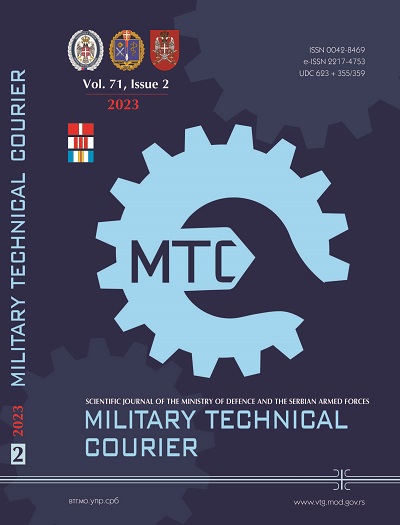Analysis of impact toughness and the critical stress intensity factor KIc in ferrite-austenite welded joints with different heat input
Abstract
Introduction/purpose: Constructions always have several critical points that can be sources of possible defects. All these critical places must be taken into account in safety assessment where the most unfavorable exploitation factors are considered and the local safety of a joint is assessed. Today, joints of various compositions are becoming more frequent in metal constructions. Due to the requirements of economy and ecology, welded joints of microalloyed ferritic steels with high-alloyed austenitic steels are increasingly encountered during the construction of power plants, chemical facilities, etc. Tests of such welded joints have been performed on tanks for oil derivatives, where parts of the tank shell are made of microalloyed ferritic steel and the roof structure is made of high-alloyed austenitic steel.
Methods: In the paper, an experimental analysis of crack propagation in an austenitic-ferritic welded joint was performed. The welding was performed by the MIG welding process with two different heat inputs, and the same filler material MIG 18/8/6 was used. Two types of welded plates were tested. the characteristics of the base, filler and auxiliary materials and welding technologies are given. Notched test specimens with an initiated crack-type fracture were made in order to determine the impact properties and fracture mechanics parameters.
The results: The research carried out within this study aimed to compare the obtained results of the impact toughness and fracture toughness at flat deformation in a ferrite-austenitic welded joint. An evaluation of the results obtained during the testing of the experimental plates welded with different amounts of heat input is also given.
Conclusion: These test results established the dependence of the geometry of a propagating crack and the stress conditions for further crack propagation. It is possible to determine the values of the parameters that describe the behavior of the material, both in linear-elastic and in elasto-plastic fracture mechanics.
References
-ASTM International. 1989. ASTM E813 (1989) Standard Test Method for JIc a Measure of Fracture Toughness. West Conshohocken, PA, USA: ASTM International.
-ASTM International. 2017. ASTM E399-90 (1997) Standard Test Method for Plane-Strain Fracture Toughness of Metallic Materials. Available at: https://doi.org/10.1520/E0399-90R97.
-ASTM International. 2019. ASTM E1820-18 Standard Test Method for Measurement of Fracture Toughness. Available at: https://doi.org/10.1520/E1820-18.
-ASTM International. 2021. ASTM E1152-95 Test Method for Determining J-R Curves (Withdrawn 1997) [online]. Available at: https://www.astm.org/standards/e1152 [Accessed: 20 January 2023].
-British Standards Institution (BSI). 2023. Multi-part Document BS 7448-Fracture mechanics toughness tests. London, UK: The British Standards Institution (BSI). Available at: https://doi.org/10.3403/BS7448.
Bukvić, A. 2012. Research of the influence of additional materials on the behavior of ferritic austenitic welded joints. Ph.D. thesis. Belgrade: University of Belgrade - Faculty of Mechanical Engineering (in Serbian).
Bukvić, A., Petrović, D., Radisavljević, I. & Dimitrić, S. 2022. Influence of heat input on the tensile properties of austenitic-ferritic welded joints. Vojnotehnički glasnik/Military Technical Courier, 70(2), pp.409-432. Available at: https://doi.org/10.5937/vojtehg70-36252.
Golubović, T., Sedmak, A., Spasojević-Brkić, V., Kirin, S. & Veg, E. 2018. Welded joints as critical regions in pressure vessels - case study of vinyl-chloride monomer storage tank. Hemijska industrija, 72(4), pp.177-182. Avaliable at: https://doi.org/10.2298/HEMIND171009006G.
-ISO. 2022. ISO 9016:2022 Destructive tests on welds in metallic materials - Impact tests - Test specimen location, notch orientation and examination [online]. Available at: https://www.iso.org/standard/81122.html [Accessed: 20 January 2023].
-Jesenice Ironworks. 2022. Additional welding materials, catalog. Jesenice Ironworks.
Jovičić, R. 2007. Analysis of the effect of cracks on the integrity of ferritic-austenitic welded joints. Ph.D. thesis. Belgrade: University of Belgrade - Faculty of Mechanical Engineering (in Serbian).
Kumar, Y., Venugopal, S., Sasikala, G., Albert, S.K. & Bhaduri, A.K. 2016. Study of creep crack growth in a modified 9Cr–1Mo steel weld metal and heat affected zone. Materials Science and Engineering: A, 655, pp.300-309. Available at: https://doi.org/10.1016/j.msea.2015.12.053.
-Messer Tehnogas. 2008. Technical documentation: Shielding gases in welding. Belgrade, Serbia: Messer Tehnogas AD (in Serbian).
Miletić, I., Ilić, A., Nikolić, R.R., Ulewicz, R. Ivanović, L . & Sczygiol, N. 2020. Analysis of Selected Properties of Welded Joints of the HSLA Steels. Materials, 13(6), art.ID:1301. Available at: https://doi.org/10.3390/ma13061301.
Paris, P. & Erdogen, F. 1963. A Critical Analysis of Cracks Propagation Laws. Journal of Basic Engineering, 85(4), pp.528-533. Available at: https://doi.org/10.1115/1.3656900.
Rabbolini, S., Beretta, S., Foletti, S. & Riva, A. 2015. Short crack propagation in LCF regime at room and high temperature in Q & T rotor steels. International Journal of Fatigue, 75, pp.10-18. Available at: https://doi.org/10.1016/j.ijfatigue.2015.01.009.
Sedmak, A., Arsić, M., Milovanović, N., Opačić, M. & Đorđević, B. 2022. Structural Integrity Analysis of a Kaplan Turbine Cover. Procedia Structural Integrity, 37, pp.263-268. Available at: https://doi.org/10.1016/j.prostr.2022.01.083.
Smiljanić, M. 2006. Zaštitni gasovi u zavarivanju. In: DUZS Seminar, pp.36-43, July 2006. (in Serbian).
Zerbst, U., Klinger, C. & Clegg, R 2015. Fracture mechanics as a tool in failure analysis - Prospects and limitations. Engineering Failure Analysis, 55, pp.376-410. Available at: https://doi.org/10.1016/j.engfailanal.2015.07.001
Copyright (c) 2023 Aleksandar G. Bukvić, Dalibor P. Petrović, Igor Z. Radisavljević, Saša S. Dimitrić

This work is licensed under a Creative Commons Attribution 4.0 International License.
Proposed Creative Commons Copyright Notices
Proposed Policy for Military Technical Courier (Journals That Offer Open Access)
Authors who publish with this journal agree to the following terms:
Authors retain copyright and grant the journal right of first publication with the work simultaneously licensed under a Creative Commons Attribution License that allows others to share the work with an acknowledgement of the work's authorship and initial publication in this journal.
- Authors are able to enter into separate, additional contractual arrangements for the non-exclusive distribution of the journal's published version of the work (e.g., post it to an institutional repository or publish it in a book), with an acknowledgement of its initial publication in this journal.
- Authors are permitted and encouraged to post their work online (e.g., in institutional repositories or on their website) prior to and during the submission process, as it can lead to productive exchanges, as well as earlier and greater citation of published work (See The Effect of Open Access).

